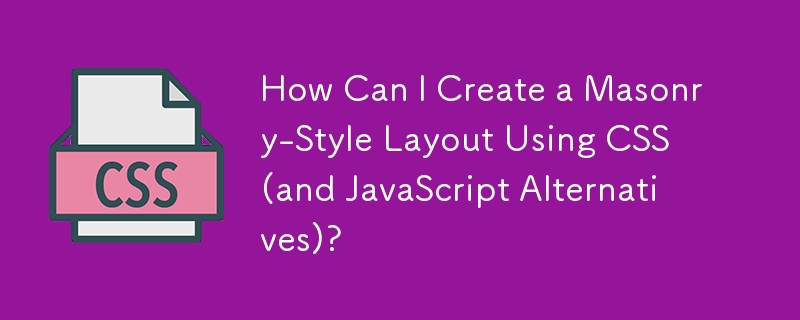 Web Front-end
Web Front-end
 CSS Tutorial
CSS Tutorial
 How Can I Create a Masonry-Style Layout Using CSS (and JavaScript Alternatives)?
How Can I Create a Masonry-Style Layout Using CSS (and JavaScript Alternatives)?
How Can I Create a Masonry-Style Layout Using CSS (and JavaScript Alternatives)?

Creating Masonry-Style Layouts with CSS
Many web designers strive to create layouts where content blocks are arranged in columns, with each block adapting to its own height while maintaining a consistent and aesthetically pleasing appearance. This is known as a masonry-style layout.
In the past, CSS alone was unable to achieve this effect effectively. However, with the advent of CSS3, we now have a simple solution.
CSS3 Solution
CSS3 introduces the concept of multi-column layouts, allowing developers to specify the number of columns and the spacing between them. By setting the column-count and column-gap properties, we can create a masonry-style layout.
For example, the following CSS code defines a container with two columns and a gap of 10 pixels between them:
.container {
column-count: 2;
column-gap: 10px;
width: 360px;
}Each item inside the container will then be forced to occupy 100% of the available width within a column. This means that blocks with different heights will stack vertically, creating the desired masonry-style appearance.
Non-CSS3 Solution
If your project does not support CSS3, you will need to use JavaScript to achieve a masonry-style layout. There are several JavaScript libraries available, such as Masonry and Isotope, that can be used to create these layouts.
The above is the detailed content of How Can I Create a Masonry-Style Layout Using CSS (and JavaScript Alternatives)?. For more information, please follow other related articles on the PHP Chinese website!

Hot AI Tools

Undresser.AI Undress
AI-powered app for creating realistic nude photos

AI Clothes Remover
Online AI tool for removing clothes from photos.

Undress AI Tool
Undress images for free

Clothoff.io
AI clothes remover

Video Face Swap
Swap faces in any video effortlessly with our completely free AI face swap tool!

Hot Article

Hot Tools

Notepad++7.3.1
Easy-to-use and free code editor

SublimeText3 Chinese version
Chinese version, very easy to use

Zend Studio 13.0.1
Powerful PHP integrated development environment

Dreamweaver CS6
Visual web development tools

SublimeText3 Mac version
God-level code editing software (SublimeText3)

Hot Topics
 1664
1664
 14
14
 1422
1422
 52
52
 1316
1316
 25
25
 1268
1268
 29
29
 1240
1240
 24
24
 Google Fonts Variable Fonts
Apr 09, 2025 am 10:42 AM
Google Fonts Variable Fonts
Apr 09, 2025 am 10:42 AM
I see Google Fonts rolled out a new design (Tweet). Compared to the last big redesign, this feels much more iterative. I can barely tell the difference
 How to Create an Animated Countdown Timer With HTML, CSS and JavaScript
Apr 11, 2025 am 11:29 AM
How to Create an Animated Countdown Timer With HTML, CSS and JavaScript
Apr 11, 2025 am 11:29 AM
Have you ever needed a countdown timer on a project? For something like that, it might be natural to reach for a plugin, but it’s actually a lot more
 HTML Data Attributes Guide
Apr 11, 2025 am 11:50 AM
HTML Data Attributes Guide
Apr 11, 2025 am 11:50 AM
Everything you ever wanted to know about data attributes in HTML, CSS, and JavaScript.
 A Proof of Concept for Making Sass Faster
Apr 16, 2025 am 10:38 AM
A Proof of Concept for Making Sass Faster
Apr 16, 2025 am 10:38 AM
At the start of a new project, Sass compilation happens in the blink of an eye. This feels great, especially when it’s paired with Browsersync, which reloads
 How We Created a Static Site That Generates Tartan Patterns in SVG
Apr 09, 2025 am 11:29 AM
How We Created a Static Site That Generates Tartan Patterns in SVG
Apr 09, 2025 am 11:29 AM
Tartan is a patterned cloth that’s typically associated with Scotland, particularly their fashionable kilts. On tartanify.com, we gathered over 5,000 tartan
 How to Build Vue Components in a WordPress Theme
Apr 11, 2025 am 11:03 AM
How to Build Vue Components in a WordPress Theme
Apr 11, 2025 am 11:03 AM
The inline-template directive allows us to build rich Vue components as a progressive enhancement over existing WordPress markup.
 While You Weren't Looking, CSS Gradients Got Better
Apr 11, 2025 am 09:16 AM
While You Weren't Looking, CSS Gradients Got Better
Apr 11, 2025 am 09:16 AM
One thing that caught my eye on the list of features for Lea Verou's conic-gradient() polyfill was the last item:
 A Comparison of Static Form Providers
Apr 16, 2025 am 11:20 AM
A Comparison of Static Form Providers
Apr 16, 2025 am 11:20 AM
Let’s attempt to coin a term here: "Static Form Provider." You bring your HTML



